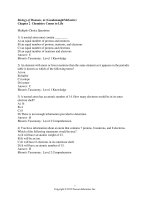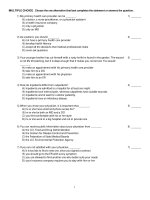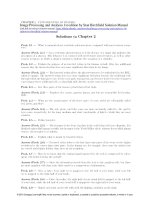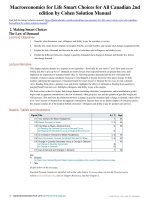International politics concepts theories and issues 2nd edition by basu solution manual
Bạn đang xem bản rút gọn của tài liệu. Xem và tải ngay bản đầy đủ của tài liệu tại đây (736.8 KB, 13 trang )
International Politics: Concepts, Theories and Issues
2nd edition by Rumki Basu Solution Manual
Link full download solution manual: />
Chapter 2
The Nation State System: National Power, Balance of
Power and Collective Security
S. R. T. P. Sugunakara Raju
Learning Objectives
To analyse the states system and to explain its evolution, characteristic
features and contemporary relevance
To comprehend the realist concept of national power, its constituent
elements and various methods of exercising it
To examine the concept of balance of power, different methods of
power balancing and its contemporary relevance
To understand the collective security system and its working both under
the League of Nations and the United Nations Organization (UNO)
Teaching Aids
Before discussing the role of the nation state system in international relations,
the instructor should explain the concepts of state and nation and the
competing theoretical perspectives on them. Trace the evolution of the
modern state system with reference to Reformation and total transformation
that occurred in the medieval European society.
Explain the contemporary state system and the impact of globalization on
the nature and role of the state—how the transformation comes about
from a welfare state to a market-oriented minimal state.
1
Discuss essential elements of national power and assess its role in foreign
policy formulation and execution.
Discuss differing definitions, assumptions and techniques of balance of
power and evaluate its contemporary relevance.
Explain the liberal ideological underpinnings of the collective security
system and how it is a superior method of maintaining international
peace and security to the balance of power system.
Explain how during the Cold War, when collective security system was
rendered dysfunctional, peacekeeping evolved as a way to limit the scope of
conflict and prevent it from escalating into a Cold War confrontation.
Suitable examples from the UN peacekeeping operations in different
countries can be given to elucidate the concept of peacekeeping and
peacebuilding in post-conflict situations.
2
The Nation State System: National Power,
Balance of Power and Collective Security
S. R. T. P. Sugunakara Raju
The Nation State System
• The academic study of ‘the states system’ or ‘the nation
state system’ is essentially a realist theoretical construction
and a way of explaining international relations.
• The modern state system with its territorial sovereignty
came into existence first in Europe in the wake of the Treaty
of Westphalia, 1648, and spread to the rest of the world in
subsequent times. It emerged during the era of Reformation,
from the medieval political climate of disorder, instability,
autarchic and closed feudal peasant economy.
• Territorial sovereignty, nationalism, sovereign equality of states
and national independence have been the organizing principles
and characteristic features of the modern state system.
The Contemporary State
System and Globalization
•
•
•
The contemporary state system is an extension and development of the European state
system as it developed in the late 18th and 19th centuries. According to K. J. Holsti, this is
characterized by the following features: the rise in the number and type of states; the rise
and predominance of essentially non-European states such as Russia, China and the
United States; the development of nuclear weapons; the growing importance of of nonstate actors such as national liberation movements and multinational corporations; and
great degree of dependence and interdependence between all types of actors.
In the wake of globalization, the relevance and role of the state has been the focus
of intense academic and political debate. Some liberal scholars argue that the state’s
power is declining and the power of the markets is ascending. Some other scholars
believe that the technological changes and liberalization of international trade,
production and finance have dealt a decisive blow to the formerly unchallenged
position of the state.
However, the neorealist scholars reject these arguments and claim that the state still
continues to be a primary actor in international politics. For realists, there is no
threat to the state and the state system will continue to be relevant.
National Power or
Capabilities and Its Elements
• Morgenthau defines national power as the power of certain individuals of a
nation who exercise it in pursuance of the policies of a nation. According to E.
H. Carr, national power may be divided into three categories: military power,
economic power and power over public opinion. As it is difficult to accurately
measure the power of states, the contemporary structural realists have
introduced the concept of ‘capabilities’ in the place of power. Kenneth Waltz
suggests that the capabilities of states can be ranked in terms of criteria such as
the size of population and territory, resource endowment, economic capability,
military strength, political strength and competence.
• A constant evaluation of national power is necessary for the success of foreign
policy. While evaluating their own power and the power of other nations, states
must keep in mind three things: (a) the relativity of power, which means that
power is always relative and not absolute, (b) no particular element or factor of
power is permanent and is subject to change and (c) overriding importance is not
to be given to one single factor to the detriment of all other factors.
Balance of Power
• There is no agreement among scholars as to the precise
meaning of ‘balance of power’. It is variously defined as
balance or equilibrium or ‘a certain amount of stability’
in international relations.
• According to Chris Brown, the root idea behind balance of
power is the notion that only force can counteract the
effect of force and that, in an anarchical world, stability,
predictability and regularity can only occur when the
forces that states are able to exert to get their way in the
world are in some kind of equilibrium. Brown, however,
uses the imagery of a chandelier to distinguish between
simple and complex types of balance of power.
Assumptions of Balance of Power
According to Quincy Wright, the following are the major assumptions that
underlie the balance of power system (Brown and Ainley, 2005: 223–24):
• States are determined to protect their vital interests (such as independence,
territorial integrity, security and so on) by the means at their disposal,
including war.
• Vital interests of the states are or may be threatened. Otherwise, there
would be no need for a state that wants to preserve the status quo to
concern itself with power relationships.
• The relative power positions of states can be measured with a significant
degree of accuracy and these power calculations can be projected onto
the future.
• A situation of ‘balance’ will either deter the threatening state from launching
an attack or permit the victim to avoid defeat if an attack should occur.
• Statesmen can and will make foreign policy decisions intelligently on the
basis of power considerations. If this were not possible, the deliberate
balancing of power could not occur.
Different Methods of Establishing
and Maintaining Balance of Power
Various methods are employed to establish or maintain balance
of power:
• The adjustment of power by domestic measures
• Alliances and counter-alliances
• Armaments and disarmament
• Divide and rule
• Compensation
• Intervention and non-intervention
• Use of buffer states
The Relevance of Balance of
Power Today
•
•
•
•
•
What is the relevance or validity of the theory of balance of power in this post-Cold
War unipolar world?
It is argued that certain developments such as expansion of democracy, the growth of
interdependence among nations and the rise of international institutions are necessarily
promoting peaceful international relations and are, thereby, rendering realism and its
concepts, such as balance of power, obsolete.
Similarly, issues such as increasing economic interdependence and globalization are
also said to have made balancing of power among nations irrelevant.
Realist and neorealist scholars, however, refute these arguments and contend that
unipolarity is the least durable of all international power configurations and it will
be replaced by multipolarity, thereby making balance of power relevant.
Another factor that makes power balancing relevant even today is the ideological
rivalry, especially among the great powers. ‘Containment of communism’ and expansion
of ‘liberal zone of peace’ always remain the primary foreign policy goals of the United
States and its liberal democratic allies. In this sense, balance of power will continue to
be relevant for a long time to come.
Defining Collective Security
and Its Assumptions
• Different writers have defined collective security differently. According to
George Schwarzenberger, collective security may be defined as a ‘machinery
for joint action to prevent or counter any attack on an established
international order’ (1964: 379).
• According to Inis L. Claude Jr, collective security is a device for
the ‘management of power’.
• The collective security ideal assumes that although wars are likely to occur,
they should be prevented, and they are prevented by restraint of military
action. In other words, wars will not occur if all parties exercise restraint.
Another assumption is that aggressors should be stopped. This assumption
presumes that the aggressor can be identified easily by other members of the
international community.
• Collective security ideal is based on certain liberal or utopian assumptions
about war and peace. It is essentially founded on the liberal notion of
‘harmony of interests’ among nations.
Collective Security System under the
League of Nations and the UNO
•
•
•
Under the League of Nations, the system of collective security was conceived as an instrument of
thwarting any attempts of aggression. However, because of the disagreements and differences among
the major powers that won the First World War, the League of Nations could only vaguely
institutionalize the idea of collective security, which lacked adequate provisions (Saksena, 1974: 10).
Unwilling to return to the balance of power system in the maintenance of international peace and
security, the founding fathers of the UN wanted to create a collective security system by which
they meant a world organization that can and will maintain the peace by force if necessary. There
was a widespread desire to create a world organization with effective powers to maintain
international peace and an improved version of collective security system.
During the Cold War period, the collective security system was not successful because of the
political, military and ideological rivalry between the two superpowers. The major limitation of
collective security system under the UN is that collective enforcement action cannot be taken
against any of the five permanent members of the Security Council as they are endowed with the
veto power. Determination of aggressor became an impossible task in the armed conflict situations,
as these great powers used or threatened to use their veto power in protecting their allies, thereby
rendering collective security system dysfunctional. The collective enforcement action was made
possible in the case of the Korean War, mainly because of the absence of the Soviet Union from the
Security Council during that time.
Peacekeeping and Peacebuilding
• During the Cold War, when collective security system was rendered
dysfunctional, peacekeeping evolved as a way to limit the scope of
conflict and prevent it from escalating into a Cold War confrontation.
Peacekeeping operations fall into two types or generations. In the first
generation of peacekeeping, the focus was on controlling conflicts
between states through third-party military forces. Peacekeeping forces
are drawn often from small and neutral non-permanent members of
the Security Council. The tasks of these forces include preventing
escalation of conflict and keeping warring parties apart until the dispute
can be settled. These multinational forces operate under the auspices
of the UN, supervising armistices, maintaining ceasefire and physically
interposing themselves in a buffer zone between warring parties.
• Peacebuilding involves developing social, political and economic
infrastructure to prevent further violence and consolidate peace.









